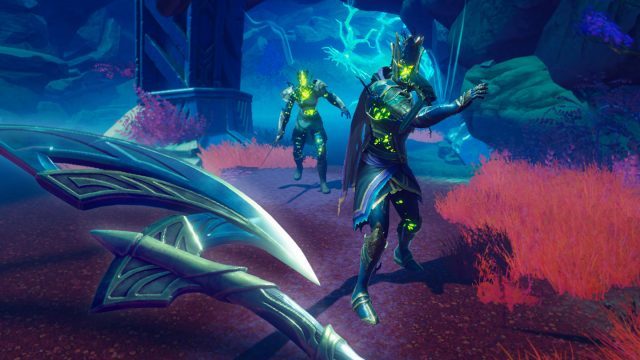In announcing Until You Fall, Schell Games was boastful about its ability to deliver an “intense, real-time combat experience that hasn’t been seen before with VR.” After spending a few hours with the pre-alpha version of the game, it’s clear that the studio wasn’t bluffing. Until You Fall’s VR melee combat system groundbreaking in its design and effectiveness.
Until You Fall is far from the first VR game to make melee combat its focus, but it seems to be the first which has truly ‘nailed it’ in the gameplay department. While a game about swinging swords and axes in VR might seem easy thanks to motion input controllers, the lack of physical feedback introduces a host of challenges.
Until You Fall solves a lot of those challenges with a melee combat system which explicitly defines the pace and motions of combat, while retaining enough flexibility and variability that the player doesn’t feel like they’re just reciting motions from a script. The weapons you use and their stats & abilities also play a major role in how you approach each enemy, offering a depth of combat that goes beyond timing. Take a look:
The combat system in a large way employs what I call ‘instructed gameplay’—the system makes clear what to do and when, while execution is up to the player. In VR this can be very compelling, because it means the player needs to move their body in interesting and satisfying ways (great games like Beat Saber, Superhot VR, and Robo Recall, all employ elements of instructed gameplay).
Players can strike enemies at any time, but after a certain number of hits, enemies will start to block and eventually begin dishing out their own attacks. In order to not take damage, players need to block incoming attacks by moving one of their weapons to an indicated location. Some enemies also strike with attacks which require the players to physically move left, right, or duck in order to avoid them. Players can continue to attack the enemy even while the enemy is swinging, but with non-regenerating health and only four strikes until you die, it’s a risky gambit.
Players can hold two weapons; the pre-alpha version of the game includes swords, daggers, maces, axes, and talismans (the latter can’t block or attack but offer generous bonuses). Each weapon has unique stats and special abilities, and each weapon type has different weight, which changes how responsive it is to your movements (daggers are fastest, followed by sword, axes, and finally, the heavy mace).

This interplay between weapon speed, stats, and abilities allows the player to make interesting (and often tough) choices about their fighting style. I found a sweet spot with a sword in my off-hand (which is great for blocking thanks to its size and speed), and an axe in my main hand (which is great for attacking thanks to its damage). But that means leaving the dagger behind, which has the very useful ability of freezing enemies for 15 seconds (a lifesaver in a situation where more than one enemy wants to gang up on you).
The combat in Until You Fall—not just the way you block and attack, but also the weapon types, stats, and abilities—really does deliver an “intense, real-time combat experience that hasn’t been seen before with VR.” It’s a framework so good, that I wouldn’t be surprised if similar mechanics become a staple of VR melee combat for years to come. Indeed, while the game is still only in pre-alpha, the foundation that Schell Games has built feels ripe for expansion by introducing new enemies, weapons, and abilities.
For the record, it would be great if the ‘instructed gameplay’ (which is essential to telling the player what to do) could be conveyed without ‘arcade style’ pop-ups showing where to block, dodge, etc; signaling all of this purely through animations and other in-world means would, in theory, be better for immersion. But the explicit signaling helps de-clunk the gameplay and create room for more depth—letting you focus on making the right moves in the right way and at the right time—while reducing the chance that a missed cue leads to a death that feels unfair or frustrating.
That said, a game like Until You Fall, depending upon its success, could be the first step toward defining a system of melee combat which becomes an expected part of a certain flavor of VR melee games. If the mechanics become familiar to a large group of players, it’s very likely that the explicit signaling can be made more subtle in future titles as the mechanics are refined over time and continually build on the knowledge and experience of players.
– – — – –
Until You Fall is set to launch in Early Access on Steam on August 27th.






